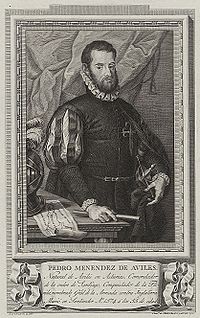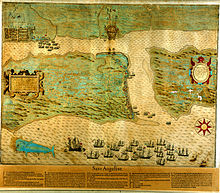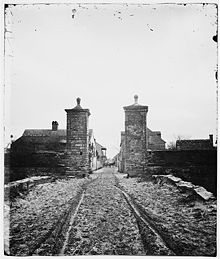History[edit]
See also: Spanish Florida
Early exploration and attempts at settlement[edit]
The first European known to have explored the coasts of Florida was the Spanish explorer and governor of Puerto Rico, Juan Ponce de León, who likely ventured in 1513 as far north as the vicinity of the future St. Augustine, naming the peninsula he believed to be an island "La Florida" and claiming it for the Spanish crown.[10][11] Prior to the founding of St. Augustine in 1565, several earlier attempts at European colonization in what is now Florida were made by both Spain and France, but all failed.[12][13][14][15]
The French exploration of the area began in 1562, under the command of the Huguenot colonizer, Captain Jean Ribault. Ribault explored the St. Johns River to the north of St. Augustine before sailing north, ultimately founding the short-lived Charlesfort on what is now known as Parris Island, South Carolina. In 1564, Ribault's former lieutenant René Goulaine de Laudonnière headed a new colonization effort. Laudonnière explored St. Augustine Inlet and the Matanzas River, which the French named Rivière des Dauphins (River of Dolphins).[16] There they made contact with the local Timucua chief, Seloy, a subject of the powerful Saturiwachiefdom,[17][18][19] before heading north to the St. Johns River. There they established Fort Caroline.[20]
Later that year a group of mutineers from Fort Caroline fled the colony and turned pirate, attacking Spanish vessels in the Caribbean. The Spanish used this as a pretext to locate and destroy Fort Caroline, fearing it would serve as a base for future piracy, and wanting to discourage further French colonization. King Philip II of Spain quickly dispatched Pedro Menéndez de Avilésto go to Florida and establish a center of operations from which to attack the French.[21][22]
Founding[edit]
Pedro Menéndez's ships first sighted land on August 28, 1565, the feast day of St. Augustine of Hippo. In honor of the patron saint of his home town of Aviles, he named his colony's settlement San Agustín.[23] The Spanish sailed through the inlet into Matanzas Bay and disembarked near the Timucua town of Seloy on September 7.[24][25][26][27] Menéndez's goal was to quickly construct fortifications to protect his people and supplies as they were unloaded from the ships, and then to make a proper survey of the area to determine the best location for the fort. The location of this early fort has been confirmed through archaeological excavations directed by Kathleen Deagan on the grounds of what is now the Fountain of Youth Archaeological Park.[24][28] It is known that the Spanish occupied several Native American structures in Seloy, whose chief, the cacique Seloy, was allied with the Saturiwa, Laudonnière's allies. It is possible, but undemonstrated, that Menéndez fortified one of the occupied Timucua structures to use as his first fort at Seloy.[24] In the meantime, Jean Ribault, Laudonnière's old commander, arrived at Fort Caroline with more settlers for the colony, as well as soldiers and weapons to defend them.[29] He also took over the governorship of the settlement. Despite Laudonnière's wishes, Ribault put most of these soldiers aboard his ships for an assault on St. Augustine. However, he was surprised at sea by a violent storm[30] that lasted several days and wrecked his ships further south on the coast. This gave Menéndez the opportunity to march his forces overland for a surprise dawn attack on the Fort Caroline garrison, which then numbered several hundred people. Laudonnière and some survivors fled to the woods, and the Spanish killed almost everyone in the fort except for the women and children. With the French displaced, Menéndez rechristened the fort "San Mateo", and appropriated it for his own purposes. The Spanish then returned south and eventually encountered the survivors of Ribault's fleet near the inlet at the southern end of Anastasia Island. There Menéndez executed most of the survivors, including Ribault; the inlet has ever since been called Matanzas, the Spanish word for "slaughters".[31]
In 1566, Martín de Argüelles was born in Saint Augustine, the first birth of a child of European ancestry recorded in what is now the continental United States,[32] 21 years before the English settlement at Roanoke Island in Virginia Colony, and 42 years before the successful settlements of Santa Fe, New Mexico, and Jamestown, Virginia. In 1606, the first recorded birth of a black child in the continental United States was listed in the Cathedral Parish archives, thirteen years before enslaved Africans were first brought to the English colony at Jamestown in 1619.[33][34] In territory under the jurisdiction of the United States, only Puerto Rico has continuously occupied European-established settlements older than St. Augustine.[35]
Spanish period[edit]
St. Augustine was intended to be a base for further colonial expansion[36] across what is now the southeastern United States, but such efforts were hampered by apathy and hostility on the part of the Native Americans towards becoming Spanish subjects. The Saturiwa, one of the two principal chiefdoms in the area, remained openly hostile.[37] In 1566, the Saturiwa burned St. Augustine and the settlement was relocated. Traditionally it was thought to have been moved to its present location, though some documentary evidence suggests it was first moved to a location on Anastasia Island. At any rate, it was certainly in its present location by the end of the 16th century.[38]
The settlement also faced attacks from European forces. In April 1568 the French soldier Dominique de Gourgues led an attack on Spanish holdings. With the aid of the Saturiwa, Tacatacuru,[39] and other Timucua peoples who had been friendly with Laudonnière, de Gourgues attacked and burned Fort San Mateo, the former Fort Caroline. He executed his prisoners in revenge for the 1565 massacre,[40] but did not approach St. Augustine. Additional French expeditions were primarily raids and could not dislodge the Spanish from St. Augustine.[41] Following the failure of the Roanoke colony in Virginia, where no survivors were discovered by an overdue supply expedition, the English blamed St. Augustine. Consequently, on June 6, 1586, English privateer Sir Francis Drake raided St. Augustine, burning it[42] and driving surviving Spanish settlers into the wilderness. However, lacking sufficient forces or authority to establish an English settlement, Drake left the area.
In 1668, English privateer Robert Searle attacked and plundered St. Augustine.[43][44] In the aftermath of his raid, the Spanish began in 1672 to construct a more secure fortification, the Castillo de San Marcos.[45] It stands today as the oldest fort in the United States. Its construction took a quarter of a century, with many later additions and modifications.[46]
The Spanish did not import many slaves to Florida for labor,[47] as it was primarily a military outpost, without a plantation economy like that of the British colonies. As the British planted settlements south along the Atlantic coast, the Spanish encouraged their slaves to escape for sanctuary in Florida. If the fugitives converted to Catholicism and swore allegiance to the king of Spain, they would be given freedom, arms, and supplies. Moving southward on the coast from the northern colonies, the British founded Charleston in 1670 and Savannah in 1733. In response, Spanish Governor Manual de Montiano in 1738 established the first legally recognized free community of ex-slaves, known asGracia Real de Santa Teresa de Mose, or Fort Mose, to the north of St. Augustine to serve as a defensive outpost.[48]
In 1740, British forces attacked St. Augustine from their colonies in the Carolinas and Georgia. The largest and most successful of these attacks was organized by Governor and General James Oglethorpe of Georgia;[49] he split the Spanish-Seminole alliance when he gained the help of Ahaya the Cowkeeper,[50] chief of the Alachua band of theSeminole tribe. The Seminole then occupied territory mostly in the north of Florida, but later migrated into the center and south of the peninsula.
In the largest campaign of 1740, Oglethorpe commanded several thousand colonial militia and British regulars, along with Alachua band warriors, and invaded Spanish Florida. He conducted the Siege of St. Augustine as part of the War of Jenkin's Ear (1739–1742). During this siege, the black community of St. Augustine was important in resisting the British forces.[51] The leader of Fort Mose during the battle was Capt. Francisco Menendez:[52] born in Africa, he twice escaped from slavery. In Florida, he played an important role in defending St. Augustine from British raids. The Fort Mose site (of which only ruins remain) is now owned and maintained by the Florida Park Service. It has been designated a National Historic Landmark.[53]




No comments:
Post a Comment